Chapter 14 — Oborea Sails Home
Had a wonderful time in the British Virgin Islands. Sparsely populated and very laid-back with the loveliest reefs over which I have snorkelled—thousands of tame tropical fish. In Road Town I met again with my old friends on Knight Errant whom I had last seen in the Grenadines four months before. Together we sailed to Normans Island, supposedly the model for Stevenson's "Treasure Island", and climbed Spyglass Hill to watch the sunrise. In Tortola, too, Oborea acquired a new crew member. Daughter of a very proper British cat and some smooth-talking island gigolo, Sunspot was seven months old when she signed on with Oborea and had never set paw ashore. She settled into her new berth quickly. In Soper's Hole B.V.I. Knight Errant parted company, heading home for England via Bermuda and the Azores, while we headed for the U.S.Virgin Islands, which turned out to be in total contrast to the B.V.I. Densely populated with heavy traffic (left hand drive cars driving on the left!) many police sporting huge revolvers on their hips and even traffic lights. In the old section of Charlotte Amalie were dozens of duty free boutiques catering to the Cruise Ship crowd, and in the 'burbs shopping centres and supermarkets (I bought a gallon of rum for less than nine dollars at Woolworths!). In this overseas territory of the U.S.A. Canadian yachts are not accorded the same privileges that they are in the continental U.S.; I had to go through all the paper work of a foreign ship when I entered at Cruz Bay, and then I had to go through it all again at my next port, Charlotte Amalie. After stocking up for the 1200 mile voyage to New York I sailed to Botany Bay, a small uninhabited cove at the west end of St Thomas to give the bottom a final scrub in warm water and spend a last day on a tropical isle. That evening I wrote in my log: "Botany bay is lovely. Deserted sand beach at the head and slow swells from the north break on the steep rocks at each side. Sitting on the deck in the stillness of the evening with a first-quarter moon high overhead I can smell the heavy scent of frangipani wafting from the shore. The only sounds are the surf on the beach and tree frogs" It was going to be hard to leave. We weighed anchor under sail at seven a.m. on May 15th and at 7:45 we passed Cricket Rock, our last land till the States, By mid morning the high islands were out of sight astern and at noon the suns altitude was 89º, 37.3' and bearing north! At half past noon a small helicopter appeared over the horizon and hovered just off our stern to advise us to change course to the west as the U.S. Navy was conducting firing exercises ahead. It seemed like a pretty good idea. For the first three days we sailed on under trade wind conditions with the wind aft. We passed over the Puerto Rico Trench, where the chart showed a sounding of 27,000 feet. It was sobering to think that at our present six knots, by the time the cat food can I tossed overboard bonked some abyssal shrimp on the head I would have travelled another sixty miles on my way. The heat was intense and we rolled on without touching a sheet or the helm, but on the fourth day the wind began to veer and increase so that by the following day we were beating into strong headwinds with long high swells sweeping in from the north. These continued for twenty four hours before they started to ease and on the seventh day we were still beating to windward, but under full working sail. The next two days brought sunny skies and perfect winds on the port beam. As the seas smoothed out we began to pick up speed, but by that evening the barometer was dropping and the wind was increasing again and next morning we had only the small jib up in a force 8 gale, the strongest sustained winds I had experienced to date. This ended abruptly with a weather phenomenon which I am still unable to explain (and we were outside the Bermuda Triangle by then too). In the sky ahead a wicked looking arch of black cloud appeared, just like the approach of a squall line. As we were already experiencing gale force winds I expected the worst, but as the arch of cloud swept overhead we emerged into sunny skies flat calm winds and the seas heaped up into lumpy masses that bounced us around for the rest of the day. May 25, the wind blew from every point of the compass varying in strength from force 5 to a flat calm. I made a record fifteen sail changes in a day as we crossed the Gulf Stream into cooler water. This was followed by beautiful sailing conditions with cool sunny skies and force 4 winds on the beam as we approached the Continental Shelf. With 100 miles to go I was confidently predicting New York by noon next day, getting in well ahead of a predicted front. I should have known better! 2am. Light winds and fog. The lights of several fishing boats loom out of the mist and I pick up Barnegat-Ambrose buoy B, fixing my position. Today is the first day of a holiday weekend and by mid morning as we creep north five miles off an invisible New Jersey coast there are people fishing everywhere around us from small boats. The weather office has down- graded the approaching front to not much more than a wind shift, but when it arrives shortly after noon it brings with it the most violent squall I have encountered. For the first fifteen minutes I drop everything and run before it and for the next fifteen I get a small jib up and heave to. Through the driving rain and spray I have seen two freighters wallowing along and over the radio I have heard the Coast Guard busily rescuing fishermen. Then it is over. We have been set back seven miles and the wind has swung dead ahead. It is cold but the fog is gone and I can see the coast. We are about fifteen miles south of Sandy Hook. All evening the wind increased and got colder. We were bucking the tide and it took until after midnight to make the Hook Channel, gaining only a short distance on each tack. It was here I almost lost Oborea. Under double reefed sails she can be reluctant to tack and I sometimes have to wear around. I was only making a few feet against the tide on each board up the channel, but from the chart I could see that once I passed a certain buoy on the starboard tack, I could continue on across shallower water and out of the current. I was just relaxing after passing this buoy and clearing the channel when I was suddenly horrified to see and hear breakers close off the lee bow. I had mis-identified the buoy and we were sailing right onto the treacherous sand banks of Sandy Hook. I put the helm down and Oborea came up into the wind where she hung for a moment before falling back toward the breakers on the same tack. What to do now? Another unsuccessful attempt to tack would put me ashore, but with her wide turning circle I was not at all sure I had room to wear around. I put the helm up as hard as it would go and Oborea swung toward the breakers gleaming and thundering against the sand ahead. The depth sounder read nothing at all under the keel. I yelled encouragement to Oborea at the top of my voice and oh so slowly she came around, first parallel to the shore which seemed right under the keel—I could see the moonlight shining on the wet sand, and then the breakers were astern and we were heading out into deeper water. I locked on the Autohelm, not caring where we were going as long as it was into deep water, and sat trembling in the cockpit. One little mistake—and so easily made after over twenty four hours without sleep... The rest of the night, although miserable and a cold thirteen degrees, was an anti-climax and by six a.m. I was off Great Kills Harbor, where it took me over half an hour to start the engine before I could motor in, anchor and sleep. After a day's rest we made a side trip through the East River to New Rochelle on Long Island Sound to pick up marine supplies at a big discount house, before heading up the Hudson to Albany where David and Neila met me for the trip through the Barge Canal. At Castleton on Hudson we went alongside to lower the masts and Sunspot took her first tentative steps ashore. The trip through the canal was routine, but Lake Ontario lived up to its usual reputation. We left Oswego for Kingston with a fine breeze from the west and under full working sail. Within an hour we were doing seven or eight knots with double reefs in and the cold spray flying across the deck in sheets. Some welcome to Home Waters! I dropped David and Neila in Kingston, and had a slow but pleasant trip down the lake under light easterlies. We arrived back at the TMCC at 0630 on June 14th 1989. The log had clicked through 14,528 miles since we left twenty months before. Sunspot went ashore to check out her new home and got pregnant.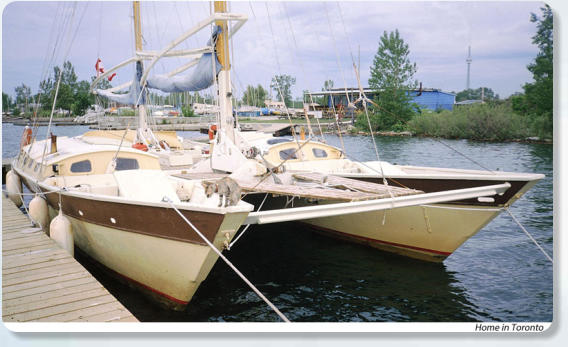
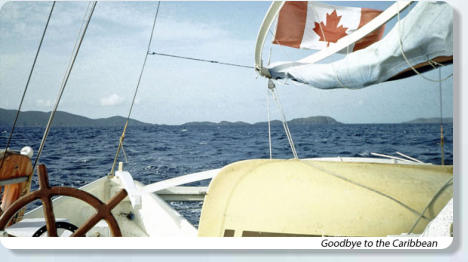
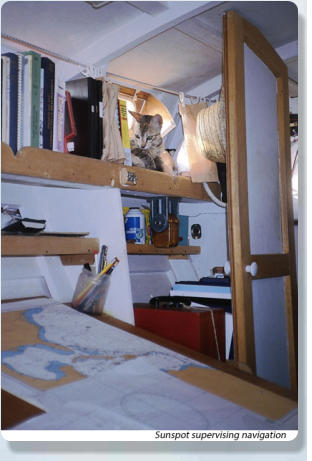
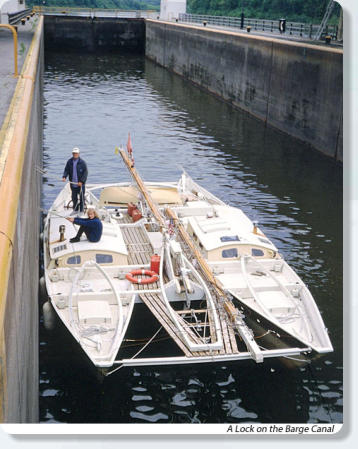
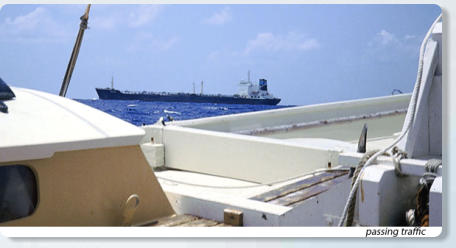
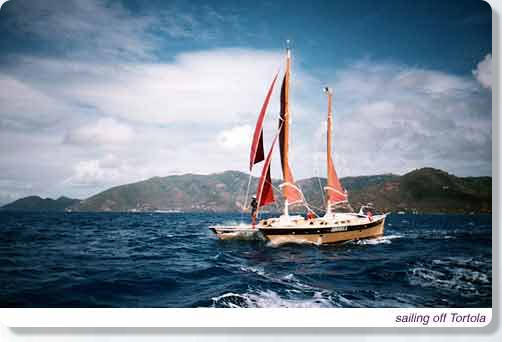
THE END OF OBOREA'S SECOND VOYAGE